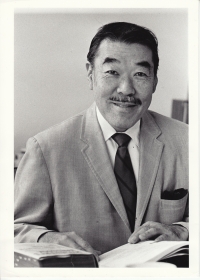Kim Yamasaki
A U.S. industrial designer born in Los Angeles CA of Japanese immigrant parents, Kim received a BA in Architecture from the University of Southern California in 1937. He worked for a few years on commercial design and studied motion picture set design at Los Angeles Art Center in 1939.
After the Japanese attack on Pearl Harbor in December 1941, In February 1942, President Roosevelt issued Executive Order 9066, which resulted in the interment in detention camps of American citizens and resident aliens of primarily Japanese ancestry from the west coast. Kim, his mother, and two sisters were interned at Granada Relocation Center in Amache, CO in late 1942. As an American citizen, Kim was allowed to leave Granada in 1943, but his mother, who under U.S. law at the time, was not allowed to become a citizen, remained interned. Kim relocated by train to Chicago, where he was employed in the industrial design office of Dave Chapman, Inc. by May 1943. Soon, he was joined there by his good friend and fellow internee from California, Albert Nozaki.
Kim worked on a number of product designs for Chapman’s firm for several years. In January 1945 he was drafted into the U.S. Army, attended military intelligence school, and served with post-war occupation forces in Japan as a designer of dependent housing, and as a translator with Japanese contractors and government. In November, he married his wife, Martha Hayakawa (1918-2003) in Chicago.
Kim was honorably discharged in October 1946 and returned to the Chapman office, where he began working on design projects, including school furniture for Brunswick Corporation, outboard motors for Johnson, Igloo ice chests, and an RCA logo and clock radio. He holds numerous design patents for products.
In 1955, Chapman reorganized his firm as Dave Chapman, Goldsmith and Yamasaki, with Kim as a partner. In 1970 the firm was re-founded by the new principals as Goldsmith Yamasaki Specht (GYS). Yamasaki entered semi-retirement in 1972 and purchased property in Yoncalla, OR, and with five other families from the York Center Cooperative in Lombard, IL (a land cooperative of 70 families), designed five contemporary homes on adjacent properties. In 1974 he left the Chicago area and moved to Yoncalla.
In 1978, Kim was awarded a National Institute of the Arts (NIA) grant an produced a book on the state of housing for the elderly. Kim enjoyed a range of interests, including current events and politics, working as a potter, drawing, reading, relaxing as a fly fisherman and attending performances in the arts. He enjoyed travel to Europe, Japan, and Australia, and was an active participant with his wife in social justice organizations in Eugene, OR, as was his wife, as well.
Due to the 1983 federal commission determination that the decision to incarcerate was based on “race predjudice, war hysteria, and a failure of political leadership,” between 1990 -1998 In 1988, survivors of the interment received belated reparation payments for their unconstitutional detention and a letter of apology signed by the President of the U.S. In 2007, the Eugene OR Japanese American Art Memorial and Garden was dedicated to commemorate the sacrifices of those who suffered wartime internment. The location is close to the site where Japanese Americans were required to register prior to being sent to camps. In the memorial, both Kim and Martha’s names are memorialized as ‘tireless workers for justice and peace’ on engraved stones donated by friends.

